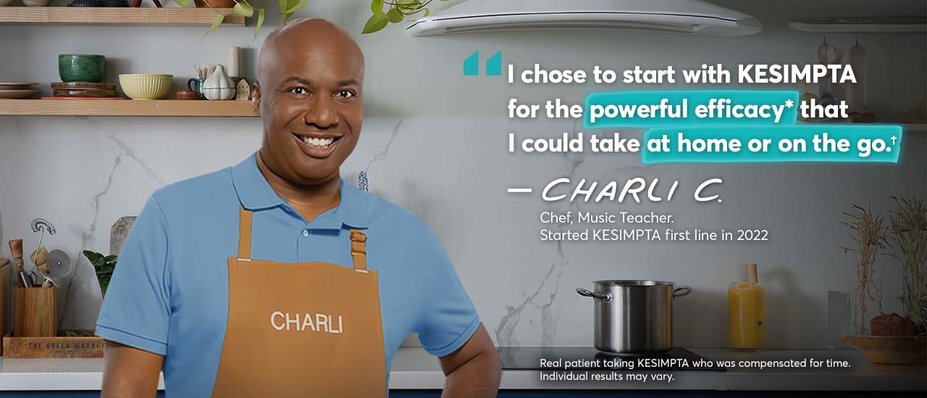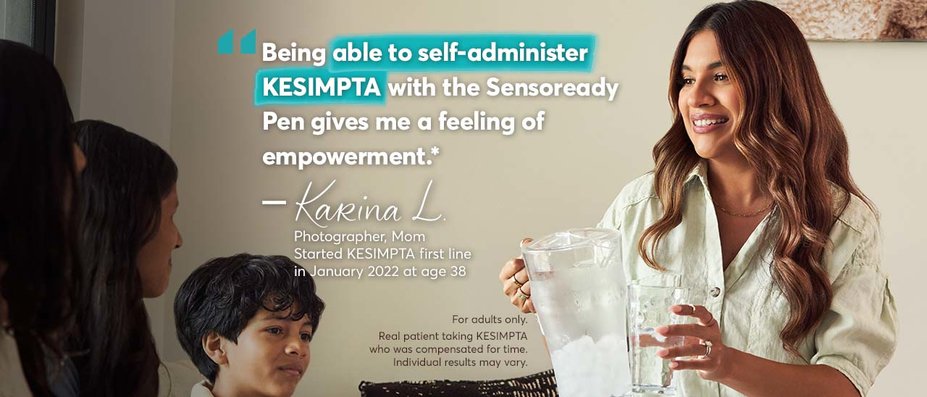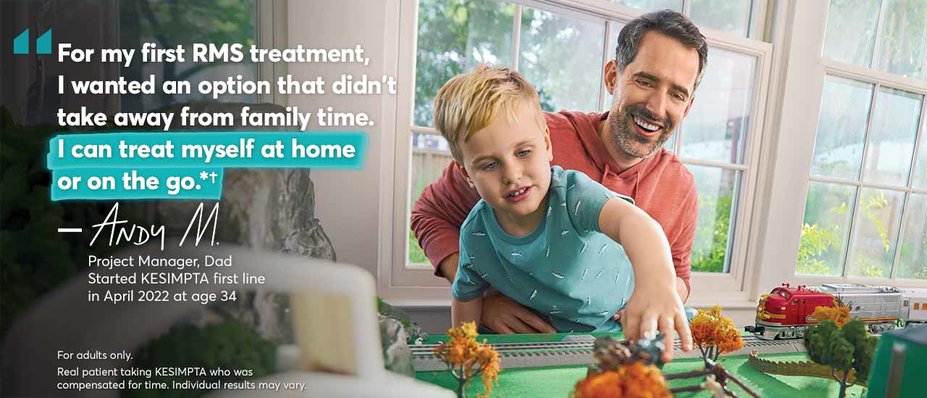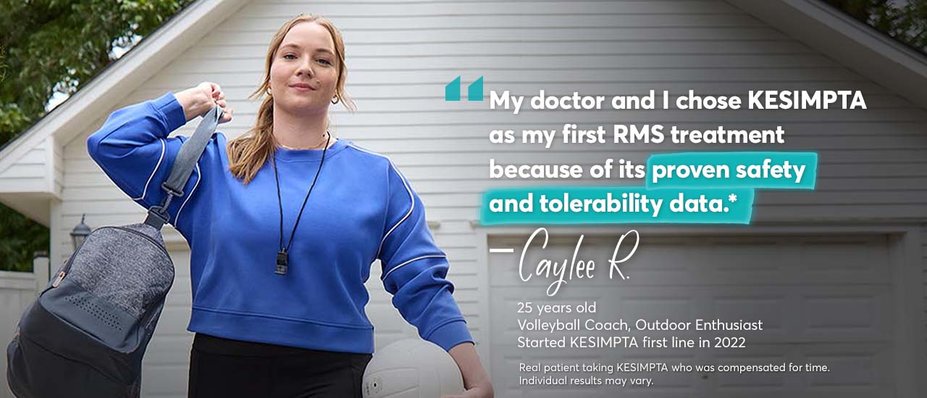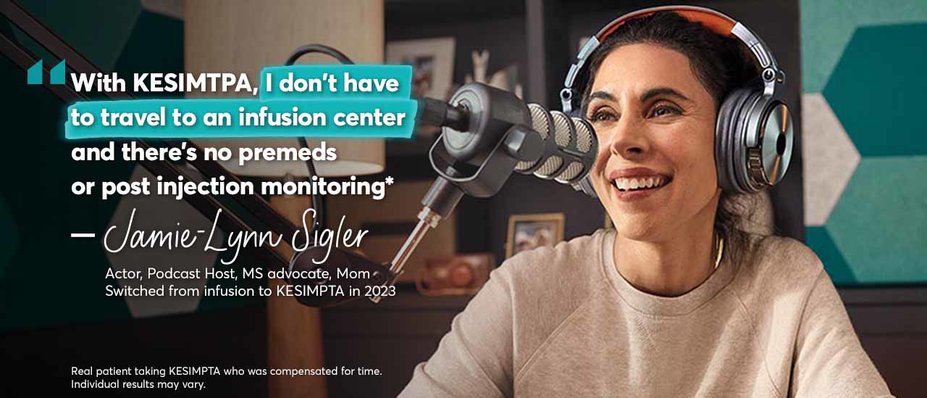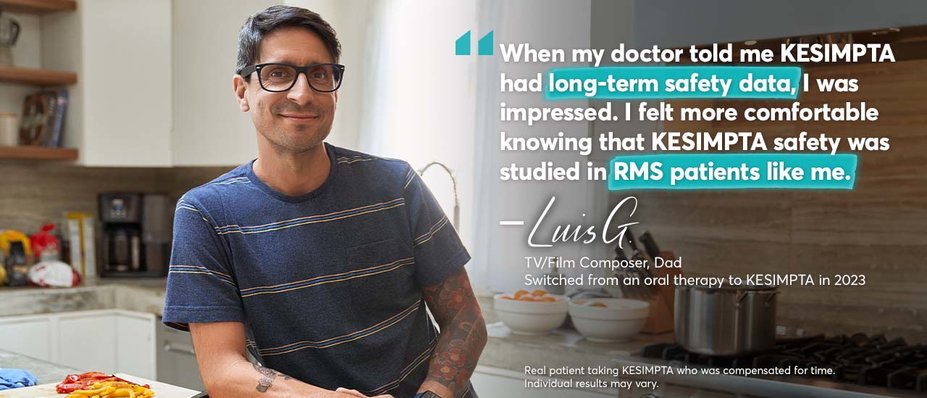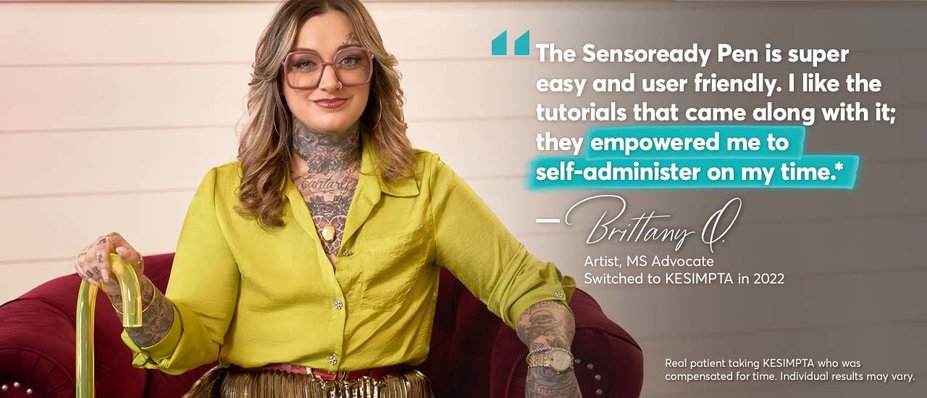
More than 150,000 patients worldwide have been prescribed KESIMPTA® (ofatumumab).1 Here are some of them.
The first choice matters. Start with KESIMPTA.
Patient history
Diagnosed in 2022 after experiencing balance issues, muscle spasms, falling, and fatigue
No relapses reported, but his initial MRI scan revealed 7 Gd+ T1 lesions in the brain and spinal cord
Charli’s experience with KESIMPTA
No relapses reported as of August 2023
Feels empowered with self-administration and finds the Sensoready® Pen easy to use,‡ especially after receiving training and a demo pen in his HCP’s office
*As evidenced by ARR, MRI (Gd+ T1 and T2 lesions), and 3- and 6-month CDP vs teriflunomide. Primary end point, ARR reduction of 51% (0.11 vs 0.22), 58% (0.10 vs 0.25).2,3
†KESIMPTA Sensoready Pens must be refrigerated at 2°C to 8°C (36°F to 46°F). Keep product in the original carton to protect from light until the time of use. Do not freeze. To avoid foaming, do not shake. If necessary, KESIMPTA may be stored at room temperature below 30°C (86°F) for up to 7 days and returned to the refrigerator, to be used within the next 7 days.2
‡Based on a cross-sectional survey of adult RMS patients (N=105) in the US who self-administered KESIMPTA with the Sensoready Pen within the previous 12 months. A total of 8 attributes of KESIMPTA Pen use were assessed, including “easy and simple to use,” “easy to prepare,” and “convenient/flexible to travel with.” 89.5% of patients scored a 4 or 5 on characteristics of overall ease of use and ease of monthly dosing schedule. Questionnaire has not been validated. Initiation of KESIMPTA in patients may be influenced by insurance and availability (among other issues). Hence, data should be cautiously interpreted.4,5
Patient history
Diagnosed in 2022 after experiencing tingling in her hands and numbness in her fingertips
No relapses reported, but her initial MRI scan revealed 5 Gd+ T1 lesions
Karina’s experience with KESIMPTA
Last MRI scan in June 2024 revealed no additional lesions or relapses
After initial medical guidance, had no difficulties self-administering KESIMPTA
Has had a positive experience with KESIMPTA and is optimistic about the future
*The first injection of KESIMPTA should be performed under the guidance of an appropriately trained health care professional. If injection-related reactions occur, symptomatic treatment is recommended.2
Patient history
Diagnosed in 2021 after experiencing numbness in his hand and tingling in his arms
Initial MRI scan revealed lesions on his brain and spine
Andy’s experience with KESIMPTA
Likes that treatment doesn’t interfere with his day-to-day activities
Finds that the pen makes it easy to self-administer after initial training
*As per stability technical specification data, when the patient is ready to inject, it typically takes less than 1 minute a month to administer. Once monthly dosing begins after the initial dosing period, which consists of 20-mg SC doses at weeks 0, 1, and 2. Please see Instructions for Use for more detailed instructions on preparation and administration of KESIMPTA.2,6
†KESIMPTA Sensoready Pens must be refrigerated at 2°C to 8°C (36°F to 46°F). Keep product in the original carton to protect from light until the time of use. Do not freeze. To avoid foaming, do not shake. If necessary, KESIMPTA may be stored at room temperature below 30°C (86°F) for up to 7 days and returned to the refrigerator, to be used within the next 7 days.2
Patient history
Diagnosed in 2021 after being diagnosed with optic neuritis
Initial MRI scan revealed 10 Gd+ T1 lesions
Caylee’s experience with KESIMPTA
Injection reactions eased after the starting regimen
As of her last checkup in July 2024, Caylee has shown no new or enlarging lesions and has reported no relapses to date
*Comparable to Aubagio® (teriflunomide), an oral therapy.2,7,8
Choose KESIMPTA first for your treatment-naïve RMS patients
These patients switched to KESIMPTA. See why.
Patient history
Proactively discussed a treatment change with her doctor
Diagnosed with RMS at age 20 while filming her hit TV show
Travels frequently with long hours on set
Jamie-Lynn’s experience with KESIMPTA
Treatment has been working for her
Loves being able to self-administer KESIMPTA at home or on set†
Appreciates the hands-on patient support of Alongside™ KESIMPTA
*Only limited benefit of premedication with corticosteroids, antihistamines, or acetaminophen was observed in RMS clinical studies. The first injection of KESIMPTA should be performed under the guidance of an appropriately trained health care professional. If injection-related reactions occur, symptomatic treatment is recommended.2
†As per stability technical specification data, when the patient is ready to inject, it typically takes less than 1 minute a month to administer. Once monthly dosing begins after the initial dosing period, which consists of 20-mg SC doses at weeks 0, 1, and 2. Please see Instructions for Use for more detailed instructions on preparation and administration of KESIMPTA.2,6
Patient history
Diagnosed in 2016 at age 34, after presenting with fatigue, numbness, optic neuritis, relapse
Struggled with compliance on her previous oral DMT
Zenovia’s experience with KESIMPTA
Likes that she can take KESIMPTA once a month at home†
No side effects were experienced on monthly maintenance doses
She has not missed a single dose of KESIMPTA
*Based on a cross-sectional survey of adult RMS patients (N=105) in the US who self-administered KESIMPTA with the Sensoready Pen within the previous 12 months. A total of 8 attributes of KESIMPTA Pen use were assessed, including “easy and simple to use,” “easy to prepare,” and “convenient/flexible to travel with.” 89.5% of patients scored a 4 or 5 on characteristics of overall ease of use and ease of monthly dosing schedule. Questionnaire has not been validated. Initiation of KESIMPTA in patients may be influenced by insurance and availability (among other issues). Hence, data should be cautiously interpreted.4,5
†As per stability technical specification data, when the patient is ready to inject, it typically takes less than 1 minute a month to administer. Once monthly dosing begins after the initial dosing period, which consists of 20-mg SC doses at weeks 0, 1, and 2. Please see Instructions for Use for more detailed instructions on preparation and administration of KESIMPTA.2,6
Patient history
Diagnosed in 2021 at age 46 after presenting with joint pain, numbness and tingling, incontinence, and blurred vision
Prescribed a daily oral DMT but continued to have pain symptoms multiple times a day
Hospitalized during recent relapse
Luis’s experience with KESIMPTA
Continues to take KESIMPTA and follows a healthy lifestyle
He is optimistic about the future and appreciates not going to a doctor's office or infusion center for treatment
Patient history
Diagnosed in 2019 after experiencing severe fatigue, loss of the ability to use her left leg, and falling
Her neurologist recommended KESIMPTA after her JC virus index was high on her previous treatment
Brittany's experience with KESIMPTA
Likes that she can take KESIMPTA once a month at home*
She finds the "second click" feature of the pen to be helpful, reassuring her that she'd administered the medication correctly
*As per stability technical specification data, when the patient is ready to inject, it typically takes less than 1 minute a month to administer. Once monthly dosing begins after the initial dosing period, which consists of 20-mg SC doses at weeks 0, 1, and 2. Please see Instructions for Use for more detailed instructions on preparation and administration of KESIMPTA2,6
Could your patients be ready for a switch?
ARR, annualized relapse rate; CDP, confirmed disability progression; DMT, disease-modifying therapy; Gd+, gadolinium-enhancing; HCP, health care professional; JC, John Cunningham; MRI, magnetic resonance imaging; MS, multiple sclerosis; NEDA, no evidence of disease activity; RMS, relapsing multiple sclerosis; SC, subcutaneous.
References: 1. Data on file. Cumulative patients worldwide. Novartis Pharmaceuticals Corp; East Hanover, NJ. April 2025. 2. Kesimpta. Prescribing information. Novartis Pharmaceuticals Corp. 3. Hauser SL, Bar-Or A, Cohen JA, et al. ASCLEPIOS I and ASCLEPIOS II trial groups. Ofatumumab versus teriflunomide in multiple sclerosis. N Engl J Med. 2020;383(6):546-557. 4. Ross AP, Nicholas J, Tai MH, et al. Real-world satisfaction and experience with injection and autoinjector device for ofatumumab indicated for multiple sclerosis. LB09. Presented at: Consortium of Multiple Sclerosis Centers Annual Meeting; May 31-June 3, 2023; Aurora, CO. 5. Novartis KESIMPTA Sensoready® pen survey HEORUSV201392. June 2022. 6. Data on file. Injection time. Novartis Pharmaceuticals Corp; East Hanover, NJ. June 2020. 7. Hauser SL, Bar-Or A, Cohen JA, et al; ASCLEPIOS I and ASCLEPIOS II trial groups. Ofatumumab versus teriflunomide in multiple sclerosis. Supplemental appendix. N Engl J Med. 2020;383(6):546-557. 8. Data on file. OMB157G (ofatumumab). Summary of clinical efficacy in relapsing multiple sclerosis. Novartis Pharmaceuticals Corp; East Hanover, NJ. December 2019.

